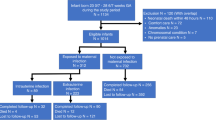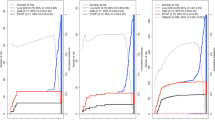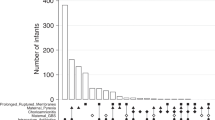Abstract
The use of Efaverinz in reproductive age women needs caution as its use in the first trimster of pregnancy is reportedly associated with an increased risk of neural tube defect (NTD) in the newborn. This concern is based on evidence from animal studies and two human case reports. We report here yet another case of encephalocele born from a mother who was taking efaverenze during conception and the first 8 weeks of gestation, the critical time in the pathogenesis of NTDs.
This is a preview of subscription content, access via your institution
Access options
Subscribe to this journal
Receive 12 print issues and online access
$259.00 per year
only $21.58 per issue
Buy this article
- Purchase on Springer Link
- Instant access to full article PDF
Prices may be subject to local taxes which are calculated during checkout

Similar content being viewed by others
References
Chersich MF, Urban MF, Venter FWD, Wessels T, Krause A, Gray GE et al. Efavirenz use during pregnancy and for women of child-bearing potential. AIDS Res Ther 2006; 3: 11.
Nightingale SL . From the Food and Drug Administration. JAMA 1998; 280 (17): 1472.
Fundaro C, Genovese O, Rendeli C, Tamburrini E, Salvaggio E . Myelomeningocele in a child with intrauterine exposure to efavirenz. AIDS 2002; 16: 299–300.
Saitoh A, Hull AD, Franklin P, Spector SA . Myelomeningocele in an infant with intrauterine exposure to efavirenz. J Perinatol 2005; 25: 555–556.
Lewis-Hall FC . Important change in SUSTIVA (efavirenz) package insert—change from category C to D. Bristol-Myers Squibb Company 2005, http://www.fda.gov, Accessed 20 February 2013.
Antiretroviral Pregnancy Registry Steering Committee. Antiretroviral Pregnancy Registry International Interim Report for 1 January 1989 through 31 July 2012. Registry Coordinating Center: Wilmington, NC, 2012 Available from URL www.APRegistry.com.
Beraa E, McCauslanda K, Nonkweloa R, Mgudlwaa B, Chackoa S, Majekea B . Birth defects following exposure to efavirenz-based antiretroviral therapy during pregnancy: a study at a regional South African hospital. AIDS 2010; 24: 283–289.
Forda N, Mofensonc L, Kranzerd K, Medue L, Frigatif L, Millsg EJ et al. Safety of efavirenz in first-trimester of pregnancy: a systematic review and meta-analysis of outcomes from observational cohorts. AIDS 2010; 24: 1461–1470.
Ford N, Calmyc A, Mofenson L . Safety of efavirenz in the first trimester of pregnancy: an updated systematic review and meta-analysis. AIDS 2011; 25: 2301–2304.
World Health Organization. Technical update on treatment optimization; Use of efavirenz during pregnancy: a public health perspective. WHO Document Production Services: Geneva, Switzerland, 2012.
Author information
Authors and Affiliations
Corresponding author
Ethics declarations
Competing interests
The authors declare no conflict of interest.
Rights and permissions
About this article
Cite this article
Gudu, W., Bekele, D. Encephalocele following a periconceptional exposure to efavirenz: a case report. J Perinatol 33, 987–988 (2013). https://doi.org/10.1038/jp.2013.121
Received:
Revised:
Accepted:
Published:
Issue Date:
DOI: https://doi.org/10.1038/jp.2013.121
Keywords
This article is cited by
-
Efavirenz
Reactions Weekly (2014)



